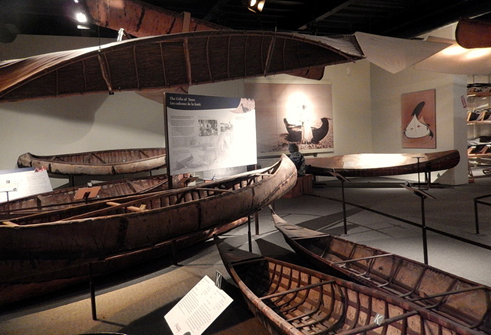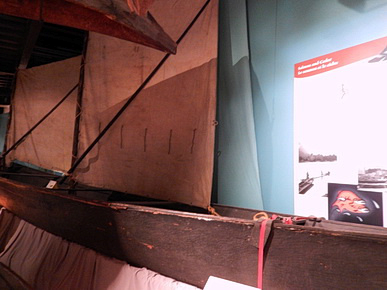9.1: Reading- The Canadian Canoe Museum
- Page ID
- 104460
Before You Read
Working with a partner or by yourself, answer the following questions.
1. What role has the canoe played in the history of the region where you live?
___________________________________________________________________
___________________________________________________________________
2. Did you know that Canada has a museum dedicated to canoes? What do you predict this reading will tell you about the Canadian Canoe Museum? Write five questions that you would like to learn the answer to.
a) ___________________________________________________________________
b) ___________________________________________________________________
c) ___________________________________________________________________
d) ___________________________________________________________________
e) ___________________________________________________________________
The Reading
Read the article below and answer the questions that follow.
1 I’ve only canoed once in my life. My day of canoeing was semi-mandatory at a day school camp for physical education and science class when I was ten years old. I haven’t gone into the water since then because I don’t know how to swim.
Canoe and kayak: Icons in Canadian cultural history
2 So why would I be writing about canoes and kayaks? They are iconic water vessels that are born from thousand-year-long cultures of native Indian groups across Canada and from the Inuit in the far Arctic. Growing up in the 1960s in Ontario, I actually didn’t learn of kayaks until later as a teen—probably because not much was revealed to southern Canadians or written about in books at that time. I saw more often the wooden, fiberglass, and birch bark canoes in photos. My friends also went camping and canoeing on Ontario’s lakes and rivers as part of their family summer vacation.
Museum still unknown, even in Ontario
3 Over fifteen years ago, I visited the fledgling Canadian Canoe Museum in Peterborough, Ontario. They had a small but impressive collection. Peterborough is 120 km northeast of Toronto in the Kawartha Lakes region by the Trent-Severn River Canal Locks. It is an area where there are forests, rivers, and lakes for cottagers and canoeing enthusiasts. Peterborough also used to have several booming companies that built canoes for the North American market in the first half of the 20th century.
4 Even now, most of my long-time Ontario friends, acquaintances, and family still aren’t aware of this fascinating, well-executed museum only an hour’s car drive (or an all-day bike ride) away from Toronto.
Showcasing Aboriginal legacy and Canadian exploration
5 I wanted to visit the museum again after its relocation to a larger, better-designed facility. Recently, the museum mounted an expansive marketing strategy designed to promote the culture and history of canoes and kayaks—a culture that’s deeply rooted in various Aboriginal cultural groups across Canada, in 17th−19th-century exploration, in map-making, and in trading within Canada by Aboriginal people and by British and French colonizers. The museum highlights canoes in iconic recreational outdoor experiences for Canadians and visitors.

6 We weren’t disappointed. In fact, we were overwhelmed by the tri-level museum with hanging canoes and kayaks artfully displayed all over the place. It was akin to walking through a carefully planned garden of canoes and kayaks. Every few steps would reveal a different mini-exhibit vista of text posters and jutting birch bark canoes at different angles and of different vintages and shapes.
7 Museum staff must have spent many months positioning unwieldy ten-foot-long long canoes and eyeballing their visual effects without cracking a lightbulb, or scratching a wall. Quite impressive.
Different canoe types and symbols
8 Different canoes and kayaks are featured—those of the west- and east-coast Indigenous groups, as well as those from the Arctic and southern Ontario. Cedar longboats and dugout boats from the Pacific coast in British Columbia were often fashioned from steaming cedar wood to shape the boat hull. I learned this a few years ago at Vancouver’s Museum of Anthropology at the University of British Columbia, where the best and most extensive museum collection of northwest coast Aboriginal artifacts can be found.
9 Some canoes were held together by caribou sinew and dried spruce tree pitch on their seams; such canoes were made of birch bark sheets. In other cases, moose hide was used to cover canoes since the skin would dry hard and stiff. The museum showed the necessity of using animal skin at a time when there was no plastic or engineered wood. In the past, Inuit women skinned seals for proper seat draping in kayaks (and for clothing). I wondered whether Inuit women ever learned to construct kayaks, since kayak construction was an occupation reserved for men. Today, the convenience of fibreglass kayaks trumps anything constructed by hand.

10 Who knew that different Canadian Aboriginal groups had different canoe designs as marked by different curves of the canoe bow? Or that there were different-shaped canoe paddles? Some canoes were traditionally decorated with beads, images of fiddleheads, eight-point stars, triangles representing traditional dwellings, and half-circles for clouds. Later, with the influence of Catholicism, a fish symbol signified that a canoe was launched on a Friday. Rabbits were magical symbols, while the enemy was the lynx.
11 The art of canoe-making is kept alive by the museum; workshops are held, where craftspeople fashion the watercraft while visitors watch and learn.
The rigour of paddlers
12 Further into the museum were large replica canoes stuffed with boxes, barrels, and baskets of goods that early explorers and traders with the Hudson’s Bay Company in the 1600s to early 1900s used to penetrate the Canadian wilderness and waters. This was no different from Aboriginal groups, who would have piled their canoes with household goods and food to move their home camps or to find sites for hunting and fishing.
13 Imagine burning off 9,000 calories a day while canoeing through wind and water rapids, and portaging (or carrying) canoe and goods overland through the forest. Our 21st-century, week-long backcountry vacation hiking would not even compare to this.
Cultural reminders and feeling very Canadian
14 This museum made me feel hopelessly Canadian. I was reminded of my Ontario schoolchild history lessons about the French fur traders in Canada in the 1600s and 1700s and about the Métis; I remembered singing a traditional French paddling folk song; and I recalled the Canadian government giving a gift of a canoe to visiting British royalty. Of course, any long-time Canadian remembers the iconic photo of our former Prime Minister Pierre Trudeau, who found peace away from politics in his favourite activity of wilderness canoeing, either solo or with his sons.
15 I would introduce any immigrant to the Canadian Canoe Museum: the canoe remains firmly interwoven in Canadian cultural history. The cultural romance of canoeing and kayaking lingers in the exploration of a vast country.
By Jean Chong
Used with permission
Questions
A. Check Your Understanding
Answer the following questions in your own words.
1. Go back to the predictions you made in Before You Read. How many of your questions were answered in the reading? Write the answers below.
a) ___________________________________________________________________
b) ___________________________________________________________________
c) ___________________________________________________________________
d) ___________________________________________________________________
e) ___________________________________________________________________
For any questions that were not answered, use the internet to find the answers.
2. Which words do you think best describe the author’s feelings after visiting the museum? Choose all that apply.
_____ interested
_____ disappointed
_____ impressed
_____ patriotic
_____ bored
_____ surprised
_____ nostalgic
_____ overwhelmed
3. a) Find one thing about the museum that impressed the author.
________________________________________________________________________
b) Find one thing about the museum that impressed you.
________________________________________________________________________
4. a) Find one thing about the museum that surprised the author.
_______________________________________________________________________
b) Find one thing about the museum that surprised you.
________________________________________________________________________
B. Develop Your Vocabulary
Answer the following questions.
1. The author uses the word semi-mandatory (para. 1). What is the opposite of mandatory? What does semi- mean?
________________________________________________________________________
2. The author uses the word iconic several times in the reading: para. 2, para. 5, para. 14. Find these sentences. What does iconic mean? In addition to the canoe, what other aspects of Canadian culture would you consider iconic?
________________________________________________________________________
3. Find the word expansive (para. 5). Now find the word extensive (para. 8). Consider also the word expensive. What do each of these three similar-looking words mean?
________________________________________________________________________
4. Find the phrase well-executed (para. 4). What are two very different meanings of the verb to execute?
________________________________________________________________________
5. Find the word fashion (para. 11). What are two very different meanings of the word fashion? What part of speech is each one?
________________________________________________________________________
C. Think about It
Think about the following questions. Write your thoughts, or discuss your ideas with your class.
1. Have you ever visited a museum? What kind of museum was it? What did you think of it?
___________________________________________________________________
___________________________________________________________________
___________________________________________________________________
2. Different visitors respond to museums in different ways. How do you think the following groups of Canadians might respond to the Canadian Canoe Museum? What would they gain from a visit?
a) Indigenous Canadians:
___________________________________________________________________
b) Canadians who trace their ancestry to Europe or elsewhere:
___________________________________________________________________
c) Recent immigrants:
___________________________________________________________________
3. What is the role of museums in keeping culture alive? Can you think of any examples of museums or historical sites where specific cultures are on display to visitors? How successful are they in showing the culture?
___________________________________________________________________
___________________________________________________________________
___________________________________________________________________
4. Imagine you are involved with establishing a museum to showcase aspects of your region’s history. How would you make sure your exhibits and information were presented accurately and sensitively?
___________________________________________________________________
___________________________________________________________________
___________________________________________________________________
D. Go Further
Visit a museum or other heritage site in your region. Note your thoughts on the following:
- The design of the museum
- Facilities for visitors (restaurant, gift shop, etc.)
- Educational programs for visitors
- Cost of admission
- Anything else that stands out
Write notes about your visit in the space below. Share your information with your class.

